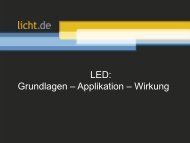licht.wissen No. 09 “Refurbishment in Trade, Commerce and Administration“
An extensive survey of offices, workshops and school classrooms shows that lots of lighting installations are obsolete. licht.wissen 09 informs that refurbishment sustainably lowers energy consumption, saves costs and makes for a significant improvement in lighting quality. This booklet from licht.de contains impartial advice for consultations with commercial clients. It also flags up web tools for assessing lighting installations and making design recommendations. Free Download at www.licht.de/en
An extensive survey of offices, workshops and school classrooms shows that lots of lighting installations are obsolete. licht.wissen 09 informs that refurbishment sustainably lowers energy consumption, saves costs and
makes for a significant improvement in lighting quality.
This booklet from licht.de contains impartial advice for consultations with commercial clients. It also flags up web tools for assessing lighting installations and making design recommendations. Free Download at www.licht.de/en
You also want an ePaper? Increase the reach of your titles
YUMPU automatically turns print PDFs into web optimized ePapers that Google loves.
16 17
lamp luminaires, the net luminous flux is
the aggregate luminous flux of the lamps
used multiplied by the light output ratio
pf the luminaire. With LED luminaires, it is
the available luminous flux stated by the
manufacturer).
New recessed luminaires need to have
the same physical dimensions as the
luminaires they replace.
The luminaires need to be electrically
compatible or appropriately upgraded
The lamps involved in a one-to-one
luminaire replacement are subject to the
requirements listed under “Lamp replacement”
(page 13).
The replacement of old luminaires and
lamps in combination with a switch to new
electronic ballasts can reduce energy requirements
by over 50 percent. This is due
partly to the greater luminous efficacy of
modern light sources, partly to the high
light output ratio of the latest luminaires as
a result of optimised reflectors and optics.
On top of that, electronic ballasts (EBs) reduce
power loss and offer flicker-free light
with no start-up delays.
Important note: Installing retrofit lamps or
other electrical components that are not expressly
recommended by the lighting system
manufacturer constitutes a structural
modification, which voids the original type
approval. In the event of damage or loss,
this could give rise to legal problems. So
when performing a retrofit, make sure that
all the components installed have the manufacturer’s
approval for use in the installation
in question. If in doubt, check with the
manufacturer.
Solution 3:
Professional design
The greatest energy savings are made
when a new installation is professionally
designed using special lighting design software.
This is the only way to harness the
technical advantages of new luminaires for
maximum energy efficiency.
Computer-designed lighting for corridors,
for example, can feature greater spacing
between light points, so fewer luminaires
are needed than with the installation that is
replaced. This option should always be
selected if the ceiling in the room is renovated.
Solution 4:
New installation with lighting
management system
If the aim is not only to save costs but
also to enhance the convenience of the
lighting, lighting control is a key requirement.
In conjunction with efficient lamps
and optimised luminaires and components,
it taps the greatest savings potential of all.
Where both presence control and daylight
regulation are integrated, energy consumption
– and thus electricity costs – can be
reduced by as much as 80 percent in
comparison to the old lighting installation
and a better quality of light is sustainably
achieved.
Radio control systems also enable presence-dependent
switching to be realised
in existing lighting installations. When
installing presence detectors, always take
account of their detection range. If in
doubt, install extension sensors.
Daylight regulation and dimmers
If daylight regulation is planned, dimmable
ballasts are essential. Most of them today
have a DALI interface. Dimmable master luminaires
with an integrated lighting management
system and similarly dimmable
slave luminaires are connected to one another
by additionally laid two-core control
cables. Offset features are recommended
for the systems installed to allow luminaires
near windows and those in deeper parts of
the room to be controlled separately.
[15] Daylight-dependent lighting control
regulates artificial lighting as required and
saves a great deal of energy.
[16 + 17] Efficient long-life LED luminaires
replace old fluorescent lamps with conventional
ballasts in a hospital corridor.
15
















